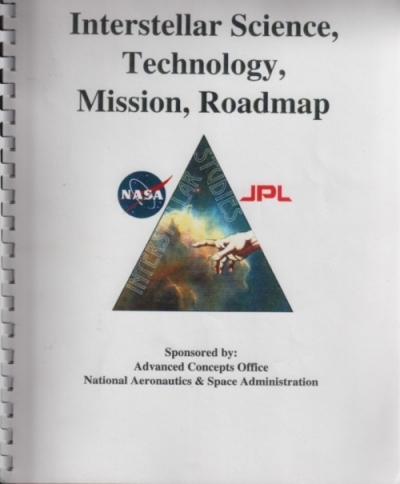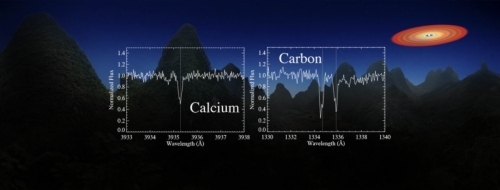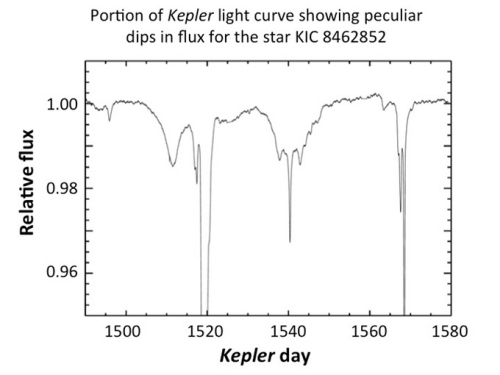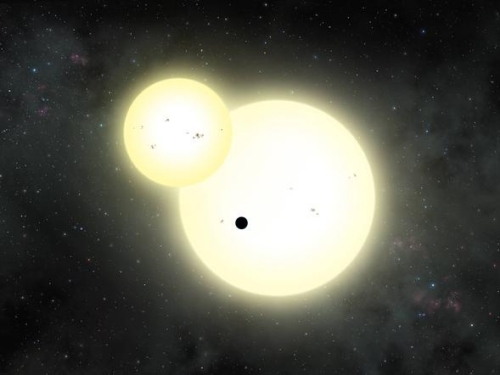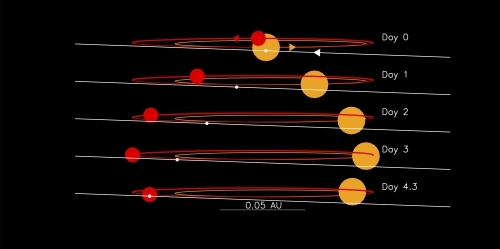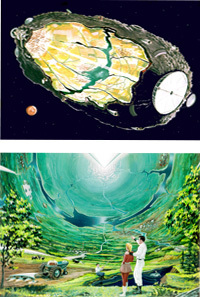Paul Gilster's Blog, page 150
June 24, 2016
A Photon Beam Propulsion Timeline
Breakthrough Starshot’s four-meter sails are the latest (and best funded) concept in a long series of beamed propulsion ideas. As Jim Benford explains below, the idea of beaming to a sail goes back over fifty years, with numerous papers and the beginnings of laboratory work in the intervening decades. What follows is the first cut at a timeline of this work, one that Jim intends to supplement and re-publish here with full references. Keeping in mind the scope of the timeline as Jim explains it, feel free to suggest any missing references in the comments. Discover Magazine, by the way, has just published a look at the Benfords’ work on beamed sails called “Riding on a Beam of Light,” now available for subscribers online.
by James Benford

From recent media pieces following the announcement of Breakthrough: Starshot, I gather that the press is not aware of how much has been done by the propulsion community over the last decades in the areas of photon beam-driven sail system concepts, to include experiments and simulations of sail beam-driven flight, sail stability (‘beam-riding’), and dynamics (such as beam-driven spin of sails for stability).
This is a brief history of the deep origins, significant events in the development of beam-driven sails for interstellar travel purposes. It excludes, for example, solar sails, launch to orbit, and mass beams. For those interested in mass beams, my thoughts on the subject, with references, appear in several earlier articles here [see, for example, Sails Driven by Diverging Neutral Particle Beams] as well as in a JBIS review article by Nordley and Crowl (“Mass Beam Propulsion, An Overview”, JBIS 68, pgs. 153-166, 2015).
First mention of beam-driven propulsion for interstellar purposes in the refereed literature was by Bob Forward, in Missiles and Rockets in 1962. More people perhaps read the Marx paper in Nature four years later, but Marx didn’t pursue his idea further, at least not in the literature.
But Bob did continue to work on it and built the foundations of the subject. This is described in his unfinished autobiography, Fast Forward Fifty Years.
My thoughts on the timeline of significant events, meaning ideas and actions that advanced the field and influenced following events, including recent milestones, follow below.
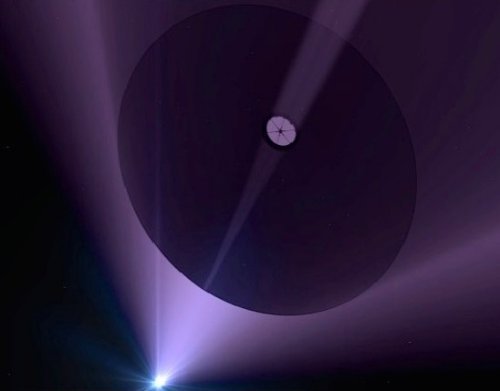
Image: Beamed propulsion leaves propellant behind, a key advantage. Coupled with very small probes, it could provide a path for flyby missions to the nearest stars. Credit: Adrian Mann.
The Visionary Era
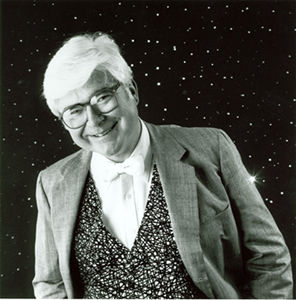
1962: First mention of beam-driven propulsion for interstellar purposes in the refereed literature, by Bob Forward, in “Pluto – Gateway to the Stars,” in Missiles and Rockets.
1966: G. Marx publishes the concept for Interstellar Vehicle Propelled by Laser Beam’ in Nature. He considered only x-rays to drive the sail, because he flinched from large apertures for the antenna and sail.
1967: Robert Forward and Eugene Mallove publish the first Interstellar Bibliography.
Image: Interstellar propulsion theorist Robert Forward.
1975: Richard Dickinson and Robert Brown demonstrate efficient transmission of 34 kW over 1.5 km.
1976: Robert Forward proposes a roadmap for interstellar exploration with a launch to Alpha Centauri in 1995.
1980: Bruce Murray, director of JPL, convenes a workshop to make a concept for an interstellar probe. Members include Freeman Dyson, Robert Forward, Robert Bussard, William Fowler and Robert Leighton. Dyson and Forward quantify Forward’s 1962 concept, including a means of returning a payload. Murray is disappointed by the large size of the sail and beamer, as well as the enormous power required. The Workshop papers are never published. Forward continues work on his concept.
1982: Robert Forward proposes laser-driven return star missions in his science fiction novel Flight of the Dragonfly . The final expanded version, Rocheworld , with technical appendix, appears in 1990.
1984: Forward presents “Roundtrip Interstellar Travel Using Laser-Pushed Sails,” the first detailed analysis showing the feasibility of the lightsail concept.

Image: Forward’s separable sail concept used for deceleration, from his paper “Roundtrip Interstellar Travel Using Laser-Pushed Lightsails,” Journal of Spacecraft and Rockets 21 (1984), pp. 187-195. The ‘paralens’ in the image is a huge Fresnel lens made of concentric rings of lightweight, transparent material, with free space between the rings and spars to hold the vast structure together, all of this located between the orbits of Saturn and Uranus.
1985: Forward proposes microwave beam-driven interstellar flybys in “Starwisp: An Ultra-Light Interstellar Probe.” He also introduces the ‘smart sail’ concept whereby the sail contains microcircuits which capture images and diagnostic data, returns data to Earth.
1986: Forward conducts first study of dielectric film sails.
1989: Geoffrey Landis analyzes the laser driven lightsail, concluding that the performance is driven by the temperature limits of the sail, and proposes refractory dielectric films as sail material.
First Steps
1999: NASA Advanced Concepts Office, largely driven by JPL, proposes a roadmap for interstellar exploration with a launch to Alpha Centauri in 2028. Limited funding of initial studies and experiments follow.
Image: Plan for the development of sails for interstellar flight, 1999.
1999: Tim Knowles of ELSI invents the carbon micro-truss, a strong, very low areal mass density graphite sheet that doesn’t melt; it sublimes at very high temperature.
1999: Geoffrey Landis and James Benford propose using the new carbon micro-truss, strong structures of very low mass per square meter. They show that, with this material, a laboratory experiment can demonstrate microwave beam-powered sailing.
December 20, 1999: Leik Myrabo-led team measures deflection of a pendulum moved by laser beam hitting sails of carbon micro-truss, giving acceleration of 0.8 gravities.
Feb 2000: Geoff Landis reexamines use of dielectric films for highly reflective sails, points out drawbacks to multiple layers.
March 2000: Gurkirpal Singh of JPL, in a dynamics simulation, shows that conical sails can ride a beam stably.

April 5, 2000: James Benford-led team achieves first flight, at JPL. Sails of carbon micro-truss, driven by microwave beam, are accelerated up to 13 gravities; sails are recovered intact. They discover the highest accelerations are due to desorption of deeply embedded chemicals when the sail reaches high temperatures. Experiments are described in “Microwave Beam-Driven Sail Flight Experiments.”
June 12, 2000: James Benford-led team spins a suspended micro-truss sail with circularly polarized microwave beam. Basic physics of spin-driven effects are demonstrated.
Image: First flight of beam-driven sail. Carbon sail lifts off truncated rectangular waveguide under 10 kW microwave power. (4 frames, 30 ms interval, 1st at top).
July 2000: Geoff Landis, in “Starwisp Revisited,” substantially reduces mass and power required for microwave-driven mesh sail.
2002: Stable beam-riding of a conical sail on a microwave beam demonstrated experimentally by the Benford brothers, Gregory and James, at UC Irvine. Physics of spin-driven effects on various sail shapes are explored in both experiment and theory.
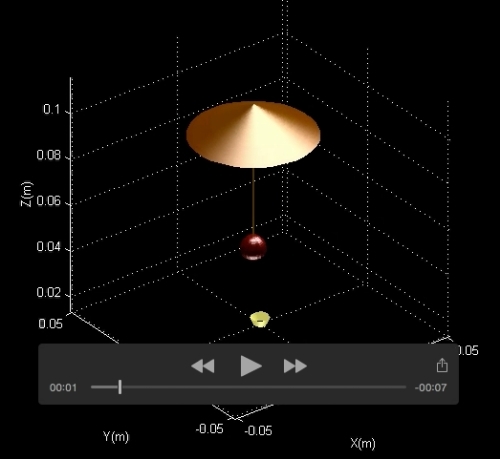
Image: Geometry of 3-D sail simulation used to access sail stability. Beam is injected from horn at bottom.
2003: Chaouki Abdallah and team at UNM, with a 3D dynamics simulation, confirm that the conical (umbrella) sail is the most passively stable shape, while other shapes, such as inverse conical, are not stable. They quantify the stable parameter range for beam shape, angle of the cone and location and mass ratio if sail and payload. They show that active dynamic feedback control can stabilize most shapes.
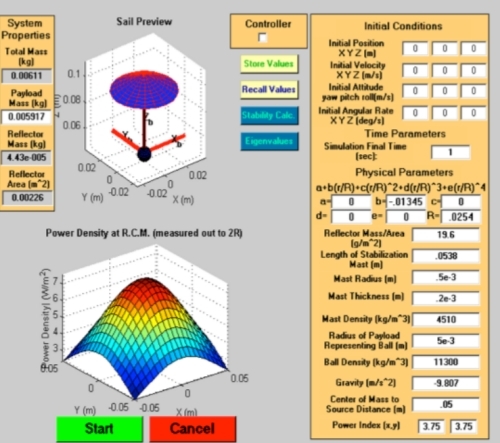
Image: Graphic user interface for sail stability simulation, Chaouki Abdallah 2003. Geometry
of sail shown above, power distribution of beam shown below.
Becoming Real
May 21, 2010: First deployment of a functional solar sail in space, “IKAROS” (Interplanetary Kite-craft Accelerated by Radiation Of the Sun) is demonstrated by the Japanese Space Agency JAXA.
2011: “100 Year Starship”, a joint project between NASA (Pete Worden) and DARPA (David Neyland), convenes a colloquium in Orlando to discuss interstellar travel, stimulating interest in practical starflight.
2012: Greg Matloff proposes graphene for sail material that can sustain high accelerations.
2013: Starship Century Symposium held at UC San Diego May 20, date of the publication of the book Starship Century . A second Starship Century Symposium is held at the Royal Astronomical Society in London. In the book James Benford predicts “the first starship will be a sail – a sailship – driven by a beam of photons.”
2013: James Benford creates a cost-optimization equation for beam-driven propulsion systems.
April 2015: Philip Lubin introduces concept for small ultra-light ‘spacecraft on a wafer’ using multi-layer dielectric on metalized plastic film. In “A Roadmap to Interstellar Flight,” Lubin draws on Forward’s laser-sail work and extends it into much smaller sail designs.
August 2013: 1st Interstellar Congress held in Dallas, Texas by Icarus Interstellar. Eric Malroy introduces concepts for the use of nanomaterials in sails.
March 2016: Yuri Milner concludes the only credible way to achieve interstellar travel in the near-term is beam-driven sails.
April 12, 2016: Yuri Milner, Stephen Hawking and Pete Worden announce the beginning of Breakthrough Starshot, a project to launch beam-driven sails to Alpha Centauri within 20 years. Freeman Dyson is present.
2016: Kevin Parkin creates an engineering inference engine for optimizing beamed sail systems, including cost minimization.
April 15, 2016: Breakthrough: Discuss, a 2 day symposium, brings together the Breakthrough Starshot team, as well as that of Breakthrough: Listen, a SETI project begun it 2015.
The notional timeline for Starshot is said to be 10 years of R&D, 10 years for construction of the System, 21 years transit time for the first sailcraft. At 0.2 c, it would enter the Alpha Centauri double-star system in 2057, a century after the first Earth satellite.
“Make no mistake — interstellar travel will always be difficult and expensive, but it can no longer be considered impossible.”
–Robert Forward, 1985
We owe it to the future to record our past. What I have described is journalism, but journalism is only the first draft of history. Doubtless there are significant events I have forgotten or never knew. Please suggest additions and modifications. A revised timeline will appear later, including references.
I thank those who I interviewed over the years about history: Robert Forward, Freeman Dyson, Geoff Landis, Kevin Parkin, Gregory Benford and Gregory Matloff.






June 23, 2016
Revisiting Enceladus’ Ocean
As we saw yesterday, there is a case to be made that the ocean beneath Pluto’s ice is still liquid, based on phase changes in ice under varying pressures and temperatures. Today we turn to another world with interesting oceanic possibilities, Enceladus. Here the data are problematic and contradictory. Flybys by the Cassini Saturn orbiter detected tiny deviations in the spacecraft’s trajectory that could be used to measure the gravity of the Saturnian moon.
Weighing these perturbations in the spacecraft’s motion against the known topography of Enceladus, scientists could draw tentative conclusions about the moon’s internal structure. Enceladus appeared to be internally asymmetric, with an ice shell between 30 and 40 kilometers thick in the southern hemisphere, perhaps thickening to 60 kilometers at the equator. Moreover, the Cassini data were not sufficient to conclude anything about the extent of the ocean. Did it extend beneath the entire shell, or was it confined largely to the southern polar regions?
Work out of Cornell University in 2015 charted some 5800 surface features at different angles and times, bringing dynamical modeling and statistical analysis to bear on Enceladus’ interior. Peter Thomas and team found that they could use a wobble in the moon’s rotation — a libration — to show that the surface of Enceladus was not solidly connected with its core. The libration, then, told us that the ocean was global. It also pointed to thinner ice, with a mean thickness of about 20 kilometers, a result inconsistent with the Cassini gravity studies.
To resolve the contradiction, a new model from a team of international researchers now proposes an asymmetric model with a strong heat source. The work sees a rocky core with radius of 185 kilometers, an internal ocean about 45 kilometers deep, and an ice shell with a mean thickness of around 20 kilometers except at the south pole, where it appears to be less than 5 kilometers thick. The ocean in this model comprises about 40 percent of the total volume of Enceladus, and the salt content is estimated to be similar to that of Earth’s oceans.
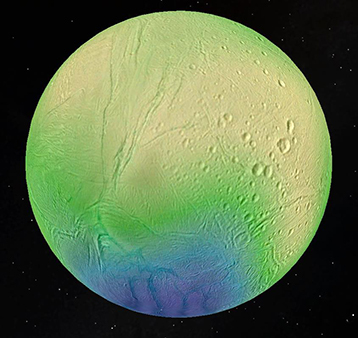
Image: The thickness of Enceladus’s ice shell, which reaches 35 kilometers in the cratered equatorial regions (shown in yellow) and less than 5 kilometers in the active south polar region (shown in blue). Credit: LPG-CNRS-U. Nantes/U. Charles, Prague.
Relatively thin ice in the south polar regions is promising for future exploration. But while this model gives us a way to reconcile previous results, it also offers another question. A thinner ice shell holds less heat, which means tidal stresses caused by Saturn can no longer explain the heat flow affecting the south polar region. We must be dealing with strong heat production deep inside Enceladus that may be driving hydrothermal venting on the ocean floor.
And yes, complex organic molecules have been found in the plumes from Enceladus, making for an astrobiologically interesting scenario when coupled with a warm ocean. But we’ll need a closer look to find out whether the model put forth by Ondřej Čadek (Charles University, Prague) and his colleagues at the Royal Observatory of Belgium and the Laboratoire de Planétologie Géodynamique de Nantes holds up. Thin ice at the south pole could offer us a window into the ocean, a study relevant not just to Enceladus but many icy objects in the outer system.
The paper is Čadek et al, “Enceladus’s internal ocean and ice shell constrained from Cassini gravity, shape, and libration data,” published online by Geophysical Research Letters 11 June 2016 (abstract).






June 22, 2016
Pluto: Evidence for a Liquid Internal Ocean
What accounts for Pluto’s interesting landscape? As we accumulate more and more data from New Horizons, we’re seeing a wide range of geologic activity on the surface, most of it involving such volatile ices as nitrogen, carbon dioxide and methane. But look at the troughs and scarps — some of them hundreds of kilometers long and several kilometers deep — and you’re seeing what are thought to be extensional faults. These are faults associated with the stretching of the dwarf planet’s crust, and in the New Horizons imagery, they appear geologically young.
We could look toward tidal interactions with Charon for an answer to what is driving tectonic activity on Pluto, but the Pluto/Charon system has reached what a new paper on the matter calls “the end point of its tidal evolution,” with the two objects locked into a synchronous state that makes the prospect unlikely. But changes in the ice shell are another matter, and as Noah Hammond (Brown University) and his fellow researchers are learning, the sinuous faults on Pluto’s surface provide evidence for a subsurface ocean that remains liquid today, though one that is probably in the process of re-freezing.

Image: The New Horizons spacecraft spied extensional faults on Pluto, a sign that the dwarf planet has undergone a global expansion possibly due to the slow freezing of a subsurface ocean. A new analysis by Brown University scientists bolsters that idea, and suggests that ocean is likely still there today. NASA/JHUAPL/SwRI.
What Hammond, a Brown graduate student, produced with colleagues Edgar Parmentier (also at Brown) and Amy Barr (Planetary Science Institute) was a model of thermal evolution that could be fed New Horizons’ data on Pluto’s diameter and density to study its interior. The energy to melt Pluto’s internal ice could have come from radioactive elements within its core, producing an ocean that would, in the frigid conditions of the Kuiper Belt, gradually begin to refreeze. An ocean that was frozen or in the process of freezing would produce the kind of extensional tectonics we see on Pluto today, assuming it were made up of normal water ice.
But different forms of ice are the crux of the argument. For low temperatures and high pressure deep within Pluto would, in a solidly frozen ocean, produce not normal ice (Ice Ih, or ice phase one) but a rhombohedral crystalline form of ice with a highly ordered structure called Ice II. The compact structure of Ice II creates a frozen ocean of smaller volume — Ice II is 25 percent more dense than normal ice — and results in contraction rather than expansion.
We have a good deal of New Horizons imagery, but find no evidence on Pluto’s surface of such global contraction — no compressional tectonic features — leading Hammond’s team to conclude that Ice II has not formed, and that the ocean is therefore not completely frozen.
Critical to the argument is the thickness of the dwarf planet’s ice shell, because Ice II should form only if the shell is 260 kilometers thick or more. Anything less produces an ocean that can freeze without forming Ice II, and hence a frozen ocean that does not cause contraction. But the authors’ thermal model, adjusting the physical properties of both the silicate core and the ice shell, produces a shell that is closer to 300 kilometers thick. Moreover:
…the influence of volatile ices such as nitrogen and methane may be more effective at insulating the ocean than shown in our model. We assume volatiles are concentrated in the top 10 km of Pluto’s ice shell, but if methane clathrates are abundant in the entire ice shell, its thermal conductivity may be significantly reduced…, increasing the likelihood that the ocean will survive. We find that if the ice shell has a constant thermal conductivity of 3 W/m/K, a subsurface ocean survives even if the thermal conductivity of the core is high. The likelihood of ocean survival further increases when considering that as the ocean begins to freeze, impurities are excluded from the ice shell and ammonia and salt concentrations in the ocean will increase, further reducing the melting temperature.
A still liquid ocean gradually re-freezing within Pluto would generate continuing global expansion, producing extensional tectonic activity and young surface features. What we do not see are the kind of compressional tectonic features that would indicate the formation of Ice II. The paper’s conclusion, then, is that there are two possibilities: Either Pluto has an ocean today or it has an ice shell thinner than 260 kilometers. The latter could imply a frozen ocean (Ice Ih), but we still have to account for Pluto’s geologically young faults. A search of New Horizons data for evidence of current extensional tectonics is perhaps the best way to proceed.
Phase changes in ice can, according to this work, produce tectonic changes on the surface even for objects at the edge of the Solar System where energy is sparse. If this kind of tectonic activity can occur on Pluto, it should be possible on other Kuiper Belt objects, suggestive of continuing activity and perhaps a huge inventory of water in icy moons and KBOs.
The paper is Hammond, Barr and Parmentier, “Recent Tectonic Activity on Pluto Driven by Phase Changes in the Ice Shell,” in press at Geophysical Research Letters (abstract / preprint).






June 21, 2016
Young Exoplanet Highlights Migration Theories
If our Solar System had a ‘hot Jupiter’ that migrated inward after Mars, Earth and Venus had formed, would any of the terrestrial planets have survived? It’s a question worth pondering given how many hot Jupiters we’ve turned up, raising the question of how these planets form in the first place. One possibility is formation in situ, close to the parent star. But there is also an argument for migration, with planets forming in cooler regions further out in the system and migrating inward as a result of interactions with the protoplanetary disk or other planets.
Perhaps the planet known as K2-33b can help us with some of this. It is no more than 11 million years old, in an orbit that creates a transit every 5.4 days. With follow-up observations by the MEarth arrays on Mount Hopkins (AZ) and at the Cerro Tololo Inter-American Observatory in Chile, researchers led by Andrew Mann (University of Texas at Austin) have been able to determine that K2-33b is a Neptune-class world some five times the size of Earth, orbiting at a distance of about 8 million kilometers. The host is an M-class star several million years old.
“Young stars tend to be very blotchy, with starspots that can mimic a transiting planet. Our observations ruled out stellar activity and proved that the Kepler signal came from a bona fide planet,” says Elisabeth Newton of the Harvard-Smithsonian Center for Astrophysics (CfA), co-author of a study slated to appear in the Astronomical Journal. “We were also able to measure the planet’s size and orbit more accurately.”
High resolution imaging using the Keck II instrument and Doppler spectroscopy at McDonald Observatory in Texas also confirmed the planetary nature of the detection. Two teams went to work independently on this world, the second led by Trevor David (Caltech), using data from the W. M. Keck Observatory in Hawaii to validate the planet. The hope of both is that K2-33b will help us understand planet formation, particularly since the parent star still retains portions of its disk material, a fact confirmed by the Spitzer instrument. Caltech’s David comments:
“Astronomers know that star formation has just completed in this region, called Upper Scorpius, and roughly a quarter of the stars still have bright protoplanetary disks. The remainder of stars in the region do not have such disks, so we reasoned that planet formation must be nearly complete for these stars, and that there would be a good chance of finding young exoplanets around them.”
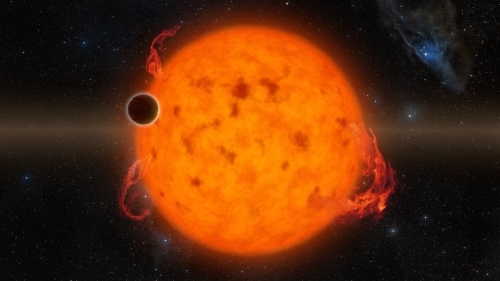
Image: K2-33b, shown in this illustration, is one of the youngest exoplanets detected to date and makes a complete orbit around its star in about five days. These two characteristics combined provide new directions for planet-formation theories. K2-33b could have formed on a farther out orbit and quickly migrated inward. Alternatively, it could have formed in situ. Credit: NASA/JPL-Caltech/R. Hurt.
Given K2-33b’s proximity to its star, migration would have occurred early indeed, or else the planet is an indication that giant planets actually form this close to their host. Mann’s team points to these possibilities and sketches a course of future research. From the paper, which is to appear in The Astronomical Journal:
The upper limit on K2-33b’s age provided by its ≃11 Myr stellar host suggests that it either migrated inwards via disk migration or formed in-situ, as planet-star and planet-planet interactions work on much longer timescales… This discovery makes it unlikely that such long-term dynamical interactions are responsible for all close-in planets. However, it is difficult to draw conclusions about the dominant migration or formation mechanism for close-in planets given the sample size and incomplete understanding of our transit-search pipeline’s completeness.
That’s a telling point, for selection effects may be at work here — K2-33b may have an atypical history that made its detection easier for a planet of this age. To learn more, we need to widen the search:
A full search of all young clusters and stellar associations surveyed by the K2 mission, with proper treatment of detection completeness is underway. This, along with improved statistics provided by the TESS and PLATO missions, will provide an estimate of the planet occurrence rate as a function of time. Trends (or a lack of trends) in this occurrence rate could set constraints on planetary migration timescales.
Publishing in Nature, Trevor David’s team takes note of K2-33b’s peculiarities, which could indeed point to the planet being an outlier:
Interestingly, large planets are rarely found close to mature low-mass stars; fewer than 1% of M-dwarfs host Neptune-sized planets with orbital periods of < 10 days, while ∼ 20% host Earth-sized planets in the same period range. This may be a hint that K2-33b is still contracting, losing atmosphere, or undergoing radial migration. Future observations may test these hypotheses, and potentially reveal where in the protoplanetary disk the planet formed.
What we do have indisputable evidence for is that a large planet can be found at a small orbital distance not long after the dissipation of the system’s nebular gas. Given the short timescales available here, the paper argues, tidal circularization of an eccentric planet or planet-planet or planet-star interactions cannot explain K2-33b’s current orbit. Formation in place or migration from within the gas disk remain as possibilities. We have a lot of work ahead to figure out just how unusual this planet is, and whether or not it is still in the process of adjusting its orbit.
The papers are Mann et al., “Zodiacal Exoplanets in Time (ZEIT) III: A short-period planet orbiting a pre-main-sequence star in the Upper Scorpius OB Association,” accepted at The Astronomical Journal (preprint); and David et al., “A Neptune-sized transiting planet closely orbiting a 5–10-million-year-old star,” Nature, published online 20 June 2016 (abstract).






June 20, 2016
Toward Gravitational Wave Astronomy
The second detection of gravitational waves by the LIGO (Laser Interferometer Gravitational-Wave Observatory) instruments reminds us how much we gain when we move beyond the visible light observations that for so many millennia determined what people thought of the universe. In the electromagnetic spectrum, it took data at long radio wavelengths to show us the leftover radiation from the Big Bang, and we’ve used radio ever since to study everything from quasars and supernovae to interesting molecules in interstellar space. Infrared helps us penetrate dust clouds and see not only into star-forming areas but the galactic center.
So much is learned by taking advantage of the enormous width of the electromagnetic spectrum, wide enough that, as Gregory Benford points out, visible light is a mere one octave on a keyboard fifteen meters wide. Ultraviolet tells us about the gaseous halo around the Milky Way and shows us active galaxies and quasars while helping us analyze interstellar gas and dust. X-rays and gamma rays deepen our understanding of black holes and matter moving at extremely high velocities, tuning up our knowledge of supernovae.
And now gravitational waves are taking us off the keyboard entirely. We’re at the dawn of gravitational wave astronomy, using distortions of spacetime itself to learn about the merging of black holes. The new detection from the LIGO team came on 26 December of last year, making the case that if we have found two black hole mergers in three months, such events must be relatively common in the universe. The work was announced at the recent meeting of the American Astronomical Society in San Diego and published in Physical Review Letters.

Image: Simulation of the motion of two black holes just before merging, and the gravitational waves they produce. Credit: Max Planck Institute for Gravitational Physics.
At a confidence level of 99.99999%, the GW151226 detection shows us a pair of black holes merging as they lose energy in the form of gravitational waves. The first detection, on 14 September 2015, involved black holes of 29 and 36 solar masses respectively. The second event involves black holes between 8 and 14 times as massive as the Sun, revealed to us in a signal that lasted about one second. Researchers believe the event took place about 1.4 billion light years from the Earth. A third possible detection came in October of 2015 but was at a much lower degree of certainty. It too is discussed in the Physical Review Letters paper.
As to GW151226 itself, we learn that the data are consistent with previous theory (public data are available here). From the Abbott et al. discovery paper:
Binary black hole formation has been predicted through a range of different channels involving either isolated binaries or dynamical processes in dense stellar systems. At present all types of formation channels predict binary black hole merger rates and black hole masses consistent with the observational constraints from GW150914. Both classical isolated binary evolution through the common envelope phase and dynamical formation are also consistent with GW151226, whose formation time and time delay to merger cannot be determined from the merger observation. Given our current understanding of massive-star evolution, the measured black hole masses are also consistent with any metallicity for the stellar progenitors and a broad range of progenitor masses.
Unlike electromagnetic waves, gravitational waves have the intriguing property that they propagate unperturbed once they have been created, which places the remote corners of the universe into our field of ‘view,’ as Asimina Arvanitaki (Stanford University) and Andrew Geraci (University of Nevada, Reno) pointed out in a 2013 paper that looked at ways to enhance gravitational wave detection. As our sensitivity to such signals increases, we should be able to move from black holes to neutron stars and supernovae, and perhaps the merger of binary stars, as events that can be examined by these techniques.
Two gravitational wave detectors are online in the United States (in Louisiana and Washington state) and one in Italy (the European Gravitational Observatory near Pisa), with Japan’s Kamioka Gravitational Wave Detector expected to become available in 2018 (I don’t know what the gravitational wave equivalent of ‘first light’ is, but maybe we should dream one up). India is working on a GW detector of its own. Five detectors will make locating the source of gravitational waves more accurate. Meanwhile, ESA’s LISA Pathfinder spacecraft (Laser Interferometer Space Antenna) is testing technologies that the upcoming eLISA (Evolved Laser Interferometer Space Antenna) will be using upon its planned launch in the 2030s.
The papers are Abbott et al., “GW151226: Observation of Gravitational Waves from a 22-Solar-Mass Binary Black Hole Coalescence,” Physical Review Letters 116, 241103 (2016) (abstract); Barausse et al., “Theory-Agnostic Constraints on Black-Hole Dipole Radiation with Multiband Gravitational-Wave Astrophysics,” Physical Review Letters 116, 241104 (2016) (preprint). The Arvanitaki and Geraci paper is, “Detecting high-frequency gravitational waves with optically-levitated sensors,” Physical Review Letters 110, 071105 (2013) (abstract).






June 17, 2016
FU Orionis: Implications of Sudden Brightening for Planet Formation
I would like to thank the many Centauri Dreams readers who contributed to the successful Kickstarter campaign to fund a year’s worth of study of KIC 8462852. As I write, there is less than an hour to go, but we have already gone well over the needed $100,000 mark. Congratulations to Tabitha Boyajian, and thanks for all the work she and her colleagues have put into this effort. Now we have a year of observations ahead using the Las Cumbres Observatory Global Telescope Network. The long-term observations will be crucial because we don’t know what to expect in terms of sudden dimming in this star’s light curve.
What a pleasure it is to write for this audience. Readers here have played a large role in pushing this project over the top, and we’ll follow the work on KIC 8462852 closely in coming days. Meanwhile, have a look at Penn State’s Jason Wright discussing ‘Tabby’s Star.’
Speaking of Unusual Stars…
If KIC 8462852 is a star that some believe is becoming less bright over time (the controversy between Bradley Schaefer and Michael Hippke is well documented here), FU Orionis is the opposite, a star whose notable brightening in 1936 is the most extreme such event we have seen around a star of Sun-like size. This is intriguing stuff, because we seem to be looking at a solar system in its infancy, undergoing a process that our own Sun may have experienced on the way toward the formation of the planets in our system. If so, this stellar activity would have changed the chemistry in the surrounding disk, with implications for how planets form.
The 1936 brightening event took FU Orionis, some 1500 light years away in the constellation Orion, from an apparent visual magnitude of 16.5 to 9.6, and the star is now around magnitude 9, with visible light observations showing a slow fade in progress. Stars like this — V1057 Signi is another — are young pre-main sequence stars in a class named after FU Orionis and nicknamed FUors. All exhibit extreme changes in magnitude and spectral type, evidently caused by the star consuming inner disk materials in a sudden feeding spree.
Joel Green (Space Telescope Science Institute) and colleagues wondered when FU Orionis might return to pre-1936 brightness levels, and what effect such brightening events could have on early system formation. The team used infrared data from the Stratospheric Observatory for Infrared Astronomy (SOFIA) and checked it against Spitzer Space Telescope data from 2004. Green presented the results, showing the star’s behavior over the twelve-year interval, at the just concluded meeting of the American Astronomical Society in San Diego.
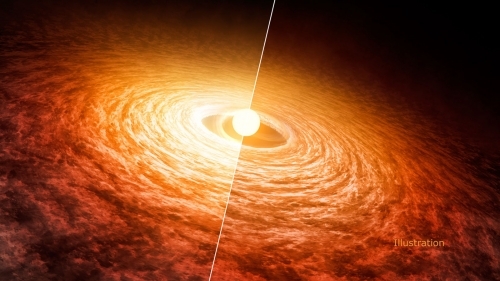
Image: This artist’s concept illustrates how the brightness of outbursting star FU Orionis has been slowly fading since its initial flare-up in 1936. The star is pictured with the disk of material that surrounds it. Researchers found that it has dimmed by about 13 percent at short infrared wavelengths from 2004 (left) to 2016 (right). Credit: NASA/JPL-Caltech.
The brightening of FU Orionis observed in 1936 was the result of the infant star devouring gas and dust from its surrounding disk, a three-month process that caused it to become 100 times brighter in short order, heating the disk to temperatures up to 7000 K. It’s clear from the most recent study that the star continues to ingest disk material. According to this JPL news release, it has consumed the equivalent of 18 Jupiters in the eighty years since the first outburst.
Even so, the SOFIA measurements confirm that the total amount of visible and infrared light from FU Orionis has decreased by about 13 percent during the twelve years since the Spitzer data were taken. The dimming is occurring at short infrared wavelengths only, an indication that about 13 percent of the hottest disk material has disappeared even as cooler materials have remained intact. Says Green:
“A decrease in the hottest gas means that the star is eating the innermost part of the disk, but the rest of the disk has essentially not changed in the last 12 years. This result is consistent with computer models, but for the first time we are able to confirm the theory with observations… The material falling into the star is like water from a hose that’s slowly being pinched off. Eventually the water will stop.”
Based on this work, we could expect FU Orionis to return to 1936 brightness levels within the next several hundred years. Still unanswered is the question of what set off the rampant activity in the first place. The fact that a protoplanetary disk can experience such sudden activity is striking. Green’s team believes that a similar event in the early Sun’s history could explain why materials close to the Sun have a different composition than those farther out, accounting for the different abundances of certain elements on Mars than on the Earth. The brightening would have had a much larger effect on the inner disk than on more distant materials.
The presentation is Green, “The Evolution of FU Orionis Disks,” American Astronomical Society, AAS Meeting #228, id.#308.05 (abstract).






Stéphane Dumas (1970 – 2016)

The interstellar community is a small one, and reporting the loss of one of our number is not easy. SETI researcher Stéphane Dumas, who had been working with Claudio Maccone on the application of the Karhunen–Loève transform (KLT) for SETI observations, has died unexpectedly at his home in Quebec. I remember a wonderful conversation with Stéphane at one of the 100 Year Starship meetings in Houston, where we got into a spirited exchange about interstellar propulsion. It was, alas, the only time I spent with the man, but he was also active on the advisory board for Jon Lomberg’s One Earth Message project, and so we interacted electronically. Below is a video of Stéphane and Claudio Maccone presenting the latest work in mathematical SETI. You’ll find Stéphane’s talk at about 34:56 on the counter.






June 16, 2016
Structure and Composition of a White Dwarf Planet
Given everything we’re learning about planets around other suns, it’s frustrating that we have so little information about the chemical composition of the rocky planets we’ve found thus far. Now we have a new study, announced at the San Diego meeting of the American Astronomical Society, that offers data on a ‘planet-like body’ whose surface layers are being consumed by the white dwarf SDSSJ1043+0855. Although it’s been known for some time that the star has been devouring rocky material orbiting around it, the new work offers a striking view of the accretion process and the composition of what was once a differentiated body.
At least, that’s the best interpretation of the data taken from the Keck Observatory’s HIRES spectrometer (installed on the 10-meter Keck I instrument) and the Hubble Space Telescope. White dwarf stars are the remains of stars like the Sun — this one was once a few times the Sun’s mass — that have gone through their red giant phase and expelled all their outer material. The ‘planet-like body’ the researchers refer to is likely the remnant of a surviving planet.
To study the chemical composition of such a world, Carl Melis (UC-San Diego) and Patrick Dufour (Université de Montreal) used the spectra of the rocky accretion material as filtered through the atmosphere of the star. The researchers believe that using these methods, they are able to analyze specific layers of the body undergoing accretion. We learn that the object shows large amounts of carbon, combined with smaller amounts of calcium and oxygen.
We may be looking, Melis and Dufour suggest, at calcium carbonate (CaCO3), a mineral widely found in shelled marine organisms here on Earth. As this news release from Keck Observatory points out, incorporating carbon in the surfaces of rocky objects is difficult, which is why the terrestrial planets in our own Solar System are sometimes described as being in a ‘carbon desert.’ The surface being accreted by SDSSJ1043+0855 shows perhaps as much as several hundred times the amount of carbon found on the surface of the Earth.
Is it possible that life played a role in this object’s history? Melis comments:
“…the presence of such high levels of carbon is unique and really needs to be explained. Our choice of calcium-carbonate as a potential carrier of the carbon provides a natural way for it to be locked up in the planet and eventually delivered to the white dwarf star, is entirely consistent with the observations in hand, and of course is suggestive. That’s really the hidden subtext. When people think about finding extra-terrestrial life, they think about Hollywood dramatizations. But the first evidence of life outside of our Solar system will probably come in a much subtler form. More likely than not, it’s going to come as a nuanced signature that may not be immediately recognizable.”
Image (click to enlarge): Artist’s impression of the surface of the massive, planet-like body being devoured by the white dwarf SDSSJ1043+0855. The Keck Observatory and Hubble Space Telescope data (shown in inset) show calcium and carbon, the presence of which can be explained with a model suggesting the surface of the planet may have been encrusted in limestone (calcium carbonate). This material was removed from the surface of the massive rocky body, probably through large-scale collisions, subsequently shredded into a disk of material, and accreted by the white dwarf star (ringed object seen in the planet’s sky). Credit: A. Hara/C. Melis/W. M. Keck Observatory.
But calcium carbonate isn’t always the result of biology, and the current work examines only the accretion materials that have been absorbed by the parent white dwarf. Melis and Dufour would like to look next at surrounding dust before it falls into the star, using the James Webb Space Telescope if possible to confirm whether calcium carbonate is present. This would allow a better estimate of whether the amount of calcium carbonate is consistent with natural processes.
Centauri Dreams’ take: Calcium carbonate or not, it’s striking that using accreted material in the region of a white dwarf and in its atmosphere can help us understand the structure of an exoplanet. We move beyond bulk chemical composition to differentiate between the layers of the body being accreted. That’s a highly useful tool for studying planetary structure.
The presentation is Melis and Dufour, “The Surface of a Limestone-Rich World?” American Astronomical Society 20 June 2016, AAS Meeting #228, id.#201.03 (abstract).






June 15, 2016
A Long-Period Circumbinary World
Before getting into today’s subject, the discovery of an interesting long-period circumbinary planet, I want to make another pitch for Centauri Dreams readers to support the Kickstarter campaign for Tabby’s Star. I’ve written often about this mysterious star whose light curves are anomalous and demand further study. Trying to find out what’s happening around KIC 8462852 means acquiring more data, and the Kickstarter campaign would provide an entire year of observations using the Las Cumbres Observatory Global Telescope Network.
We’re now down to 48 hours and of the $100,000 needed, about three-fourths has been raised. Coming down the homestretch, the remaining $24,000 should be achievable, but it looks to be a dramatic finish. If you haven’t been following the KIC 8462852 story, you can check the archives here, or for a quick overview, see my article A Kickstarter Campaign for KIC 8462852. Whatever you can do to help would be hugely appreciated as we try to learn as much as possible about what Penn State’s Jason Wright has called ‘the most mysterious star in our galaxy.’
Kepler-1647b: Insights into Planet Formation
On to the ongoing meeting of the American Astronomical Society in San Diego, where the discovery of the largest planet yet found around a double-star system was announced. That’s ‘around’ a double-star system rather than ‘in’ one, the planet in question orbiting both stars. Such circumbinary planets are welded to the imagination of Star Wars viewers because of the world Tatooine, the cinematic home of Luke Skywalker, and as in the film, they cast a hypnotic spell on the imagination as we think about what such worlds might look like.
No standing on a planetary surface to watch interesting sunsets here, though. Kepler-1647b is a gas giant, about 3700 light years away in the constellation Cygnus, and at 4.4 billion years old, it’s roughly the same age as the Earth. The planet orbits its eclipsing binary host — two solar mass stars — every 1100 days, making it the longest-period transiting circumbinary planet yet discovered. Despite the lengthy orbital period, three times longer than the Earth’s, Kepler-1647b appears to be in the circumbinary habitable zone for the entire duration of its orbit. Terrestrial moons are theoretically possible, but no evidence for them turns up in the data.
Image: Artist’s impression of the simultaneous stellar eclipse and planetary transit events on Kepler-1647 b. Such a double eclipse event is known as a syzygy. Credit: Lynette Cook.
The discovery of this Jupiter-like world is the work of a team led by Veselin Kostov (NASA Goddard). A transit was originally detected back in 2011 but additional data were needed before the circumbinary planet could be confirmed, part of the problem being the length of the planet’s orbital period. As co-author William Welsh (San Diego State University) notes: “…finding circumbinary planets is much harder than finding planets around single stars. The transits are not regularly spaced in time and they can vary in duration and even depth.”
At three years, Kepler-1647b’s orbital period is the longest of any confirmed transiting planet. The gas giant is also the largest circumbinary planet yet found since the first such world, Kepler-16b, was detected through its transits. We now know of 10 transiting circumbinary planets in eight eclipsing binary systems, and what’s intriguing here is that all of these except Kepler-1647b are near the critical orbital distance for dynamical stability. Get any closer to the binary host, in other words, and their orbits would become unstable.
But Kepler-1647b is on a much wider orbit and its large size contrasts with all previously discovered circumbinary planets, which have been Saturn-sized or smaller. Theoretical models had predicted that Jupiter-mass circumbinary worlds should be less common and should orbit at large distances from the central binary. The discovery of a gas giant on a wide orbit is thus consistent with these models. No long-period circumbinary worlds have been detected before this, a fact whose implications for planetary evolution are discussed in the paper:
As important as a new discovery of a CBP [circumbinary planet] is to indulge our basic human curiosity about distant worlds, its main significance is to expand our understanding of the inner workings of planetary systems in the dynamically rich environments of close binary stars. The orbital parameters of CBPs, for example, provide important new insight into the properties of protoplanetary disks and shed light on planetary formation and migration in the dynamically-challenging environments of binary stars. In particular, the observed orbit of Kepler-1647b lends strong support to the models suggesting that CBPs form at large distances from their host binaries and subsequently migrate either as a result of planet-disk interaction, or planet-planet scattering…
Image: The orbit of Kepler 1647b (white dot) around its two suns (red and yellow circles). Kepler-1647 b was observed transiting each of its two suns during a single orbit (days 0 and 4.3). Credit: Kostov et al.
The paper is Kostov et al., “Kepler-1647b: the largest and longest-period Kepler transiting circumbinary planet,” accepted at the Astrophysical Journal (preprint). A news release from the University of Hawaii at Manoa is also available.






June 14, 2016
Asteroids as Spacecraft
Rama is a name that resonates with science fiction fans who remember Arthur C. Clarke’s wonderful Rendezvous with Rama (1973). The novel depicts a 50-kilometer starship that enters the Solar System and is intercepted by a human crew, finding remarkable and enigmatic things that I will leave undescribed for the pleasure of those who haven’t yet read the book. Suffice it to say that among Clarke’s many fine novels, Rendezvous with Rama is, along with The City and the Stars, a personal favorite.
What a company called Made in Space Inc. has in mind is something different than Clarke’s vision, though it too evokes names from the past, as we’ll shortly see. Based in Mountain View, CA the company is embarking on an attempt to turn asteroids into small spacecraft that can move themselves to new trajectories. RAMA in this case stands for Reconstituting Asteroids into Mechanical Automata, and it proceeds by putting ‘Seed Craft’ on asteroids that will use materials found on the surface. This is the kind of in situ resource utilization (ISRU) that Ian Crawford discussed in his essay in these pages last Friday.
A suitably modified asteroid could take itself to the nearest extraction point for human mining, while the seed craft could be sent on to another asteroid. Build the system right, Made in Space believes, and you can do away with at least some of the human control needed for space operations. 3-D printing plays a big role here, no surprise given the company’s background in providing the first such printer (to the ISS in 2014) that can function in zero-g. Our friend Jon Lomberg worked with Made in Space to create a ‘Golden Plate’ commemorating the first space manufacturing operation, now attached internally to the functioning space printer.
That name from the past I mentioned above is Dandridge Cole, an aerospace engineer, former paratrooper and futurist whose death in 1965 at the young age of 44 cost the space community one of its true visionaries. Cole had plenty of ideas of his own on moving asteroids, but in his case, the idea involved more than robotic transfer into a new orbit. Much more. Why not, thought Cole, actually hollow out an asteroid to create an internal habitat? Here’s how Alex Michael Bonnici described Cole’s idea in a tribute written in 2007:
In 1963, Cole wrote Exploring the Secrets of Space: Astronautics for the Layman with I. M. Levitt. In this book they suggested hollowing out an ellipsoidal asteroid about 30 km long, and rotating it about its major axis to simulate gravity. By reflecting sunlight inside with mirrors, and creating, on its inner surface, a pastoral setting an asteroid could be transformed into a permanent space colony. Cole and Cox also envisioned that asteroids would provide the raw materials to form the basis of a spacefaring civilization. And, that asteroidal materials would also serve terrestrial needs. In their view these materials could be transported using mass drivers or linear motors. Cole’s work largely presages that of Gerard K. O’Neill by more than a decade.
Image: Aerospace engineer and futurist Dandridge Cole, who coined the term ‘macro-life’ to refer to human colonies in space and their evolution. Credit: Wikimedia Commons.
Hollow asteroids are an idea familiar to science fiction fans, who will have encountered the trope in various short stories and perhaps in George Zebrowski’s 1979 novel Macrolife. The name is carefully chosen because Cole used ‘macro-life’ to describe future human evolution within space habitats like these, a development he thought would involve a life-form incorporating technology and intimately synchronized with its environment. Putting large colonies of hollow asteroids into play would ensure our species’ survival while allowing us to progress, he believed, beyond dangers like nuclear proliferation and population pressure.
Here’s Cole in 1961, from an essay called “The Ultimate Human Society”:
This concept of a new life form which I call Macro Life and Isaac Asimov calls ‘multiorganismic life’ serves as a convenient shorthand whereby the whole collection of social, political, and biological problems facing the future space colonist may be represented with two-word symbols. It also communicates quickly an appreciation for the similar problems which are rapidly descending on the whole human race. Macro Life can be defined as ‘life squared per cell.’ Taking man as representative of multicelled life we can say that man is the mean proportional between Macro Life and the cell, or Macro Life is to man as man is to the cell. Macro Life is a new life form of gigantic size which has for its cells individual human beings, plants, animals and machines.”
Arthur Clarke liked the notion enough to call Zebrowski’s novel ‘a worthy successor to Olaf Stapledon’s Star Maker,’ which had been a major influence on Clarke and most of his contemporaries. As to the notion of moving asteroids about, an early treatment was Robert Heinlein’s ‘Misfit,’ in which an asteroid is moved out of the main belt to an orbit between Mars and the Earth. This one made its appearance in the November 1939 issue of Astounding Science Fiction, and would hardly be the last asteroid-themed tale. A more modern take shows up in Larry Niven’s Known Space stories and the memorable ‘Belters.’
Image: An engineered asteroid from without and within. Illustrator Roy Scarfo worked with Cole on the 1965 book Beyond Tomorrow. Credit: Roy Scarfo.
We’ve come a long way from Made in Space and their plans to move asteroids through ‘seed craft’ and in situ resource utilization, but what I find exciting here is the synergy between some of these ideas from the past and the conceptual studies Made in Space is performing, with help from NASA’s Innovative Advanced Concepts Program. Asteroid mining gives us a route forward as we contemplate infrastructures within the Solar System, building, we can hope, toward a society comfortable working in deep space and continuing to explore.






Paul Gilster's Blog
- Paul Gilster's profile
- 7 followers


